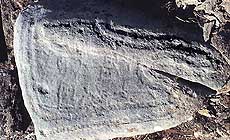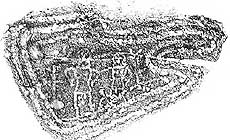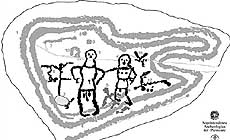|
|
 |
 |
Country: |
Italia |
Locality: |
Mompantero - see original record (ask compiler - institution) |
|
 |
Region: |
Piemonte |
Area: |
Valsusa |
|
 |
 |
|
|
|
|
| |
 |
Environment & Surface |
 |
 |
 |
|
Altitude:
|
1060 m
Open-air
Shelter
Cave
Portable
Megalithic
|
Geography: |
Rocky slope, southward exposed, panoramic site, abandoned sheep pasture, xerophilous vegetation (Juniperus, little pine-tree), stone walls, arid and windy area. Terrassment, area cultivated till 1950 (wheat, rye, vines). |
Proximity: |
Path |
|
 |
Geology: |
Filladic calcschist (metamorphic rock composed by calcite and mica). This kind of rock allows the pecking technique, but is more affected by the erosion (water and wind) than the Permian sandstone, thus the siliceous component, not soluble in water, is quite resistant. |
Surface: |
Smooth, convex, 0° of inclination, patina |
|
Dimensions:
|
Length 0.80 m.
Width 0.50 m.
Depth 0.18 m.
|
|
 |
 |
|
|
|
|
| |
 |
Art |
 |
 |
 |
Description: |
Engravings
Paintings
Painted engravings
High or low-relief
Sculpture
The two largest human figures clearly show their sex: penis, testicles, breast. They are depicted arm-in-arm. It could depict a family scene. The meander goes all around the perimetral borders, showing a large pecking. M. Rossi suggest that it could be a representation af the biblic scene of Adam and Eva and the snake. In reality the human figures superimpose the meander and so belong to a different phase.
|
Figures: |
total number 12
1 meander, 1 male figure, 1 female figure, 1 little human figure, 1 branched figure, 1 cup-mark like figure.
|
|
 |
Chronology: |
Palaeolithic
Epipalaeolithic - Mesolithic
Neolithic
Copper Age
Bronze Age
Iron Age
Roman
Middle Age
Modern
Unknown
The meander is a problematic subject to be dated. It's possible to find a double chronological attribution: Neolithic-first Copper Age (by comparison with the meanders and the spirals of the Irish passage graves and of the megalithic art) or Bronze Age - First Iron Age (by comparison with the engravings of the Haute Maurienne French valley where such patterns seem to be related to the Iron Age topographical compositions). The study of the superimpositions in the Valsusa area testify that the meandro-spiralic pattern is overlapped by late Iron Age figures, like axes. The human figures, which overlap the meander, could find some point of contact with romano-celtic human representations, but could pertain also to later phases
|
Notes: |
|
|
 |
 |
|
| |
 |
Bibliography |
 |
|
|
|
|
| |
 |
Conservation |
 |
 |
 |
Status: |
Public
Private
Park
Classified site
|
Risk: |
The stone is under the risk of being moved. Figures are visible only on a grazing light. The site is poorly attended, thus some people is passing with motorbikes along the mountain path. The surface is affected by the erosion. The area is rarely covered by snow. |
|
 |
Conservation: |
Good
Quite good
Mediocre
Bad
|
Intervention: |
The rock has been completely recorded (International western Alps rock art record), traced (contact tracing and digital vectorial rendition), photographed (normal light and grazing light colour slides) under enchargement of the Archaeological Superintendence of Piedmont. More info (Italian version) at http://rupestre.net/archiv and http://rupestre.net/alps. |
|
 |
 |
|
|
 |
By |
 |
|
| |
| Record n. 502 / 807 |
No commercial use is allowed. Specific © is mentioned in the captions or owned by each Author or Institution |
|
| |
 |
EuroPreArt, European Prehistoric Art, is a web-based archaeological project funded by the European Union which aims to establish a lasting data-base of European prehistoric art documentation, to launch the base of an European institutional network and to contribute to the awareness of the diversity and richness of European Prehistoric Art.
It is proposed by: Instituto Politécnico de Tomar (IPT, Portugal),
CUEBC - European University Centre for Cultural Heritage (Italy - Europe),
Consejo Superior de Investigaciones Científicas (España),
Asociación Cultural Colectivo Barbaón (España),
Université de Liège (Belgique),
Gotland University College (Sverige),
University College Dublin (Eire),
Cooperativa Archeologica Le Orme dell'Uomo (Italia),
Study Centre and Museum of Prehistoric Art of
Pinerolo (Italia),
The European Centre for Prehistoric Research in the Alto Ribatejo (Portugal),
ArqueoJovem - a youth NGO (Portugal).
|
|
|
|
 |
|
 NEW: Alpine rock paintings
NEW: Alpine rock paintings


